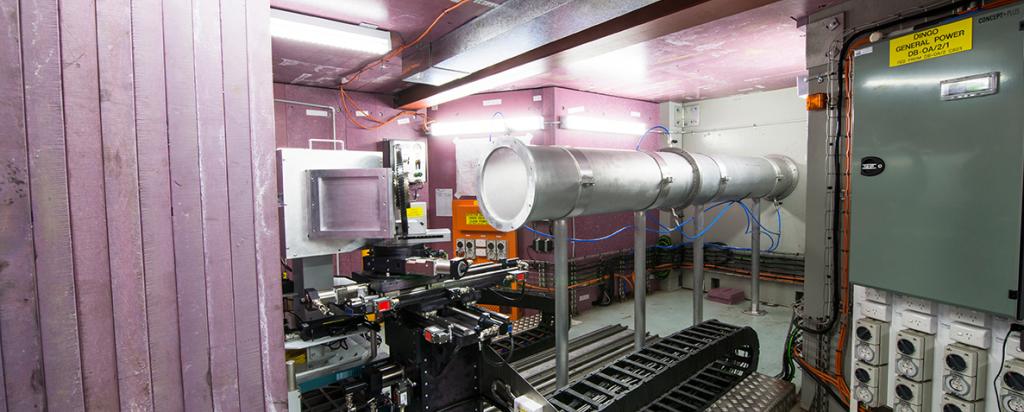
Infrastructure - Cultural Heritage
The suite of world-class neutron-beam instruments operated by the Australian Centre for Neutron Scattering, the availability of neutron activation analysis at the OPAL research reactor, the Centre for Accelerator Science, the recently assumed responsibility for operation of the Australian Synchrotron, along with state-of-the-art laboratories, offices, and computing facilities constitute an invaluable and powerful research platform.
Facilities
Neutron scattering and imaging techniques (ACNS)
Neutrons are subatomic particles that have no electrical charge and penetrate most materials to depths of several centimetres. Since neutrons interact with atomic nuclei, this results in a number of differences with equivalent X-rays and electrons methods, perhaps the most important being in the detection of light elements such as hydrogen. Neutron techniques are used to investigate structure and composition of materials non-invasively. The most relevant methods for applications to heritage materials are:
- Neutron imaging DINGO
- Neutron diffraction ECHIDNA
- Neutron stress and texture analysis KOWARI
- Small-angle neutron scattering QUOKKA, BILBY
- Ultra-small angle neutron scattering KOOKABURRA
The support of the Sample Environments group (SE) expands the capability of beamline-based experiments. Dedicated laboratories and equipment are available to manipulate the environment in which the artefacts are immersed in terms of relative humidity, pressure, temperature, gas composition etc.. The ability to combine multiple techniques in-situ facilitates the comparison/validation between laboratory analyses and neutron measurements. Complex experiments can also be designed for the users, given sufficient time and resources.
Neutron Activation Analysis (NAA)
Neutron activation analysis is a very sensitive method of quantitative multi-elemental analysis. It has the potential to determine concentrations in a sample from ppb to tens of percent, depending on the particular element and bulk matrix composition. A typical application in the field of cultural heritage is for provenance study.
Synchrotron techniques (AS)
The Australian Synchrotron produces powerful beams of light that can be used to examine the atomic and molecular detail of a wide range of materials. The results are superior in terms of accuracy, quality, robustness and the level of detail that can be seen and collected much faster than with traditional laboratory tools.
- Imaging IMBL
- X-ray fluorescence microscopy XFM
- IR Microscopy and Spectroscopy IR
Accelerator-based techniques (CAS)
The national centre for accelerator science at ANSTO features Ion Beam Analysis (IBA) and Accelerator Mass Spectrometry (AMS). IBA is used to determine what elements are present in materials. It is a fast, sensitive and non-destructive way of establishing how atoms are distributed throughout a sample. AMS is an ultra-sensitive method for analysing isotopes. A widely- recognised application of AMS is radiocarbon (14C) dating.
- Ion Beam Analyses IBA
- Accelerator Mass Spectrometry AMS
Laboratory-based instruments
Other analytical facilities are also available onsite along with sample environment laboratories and sample preparation laboratories (SE).
- X-ray Diffraction (XRD)
- Scanning Electron Microscopes (SEM)
- Transmission Electron Microscopes (TEM)
- Small-angle X-ray scattering (SAXS)
- X-ray Computed Tomography (X-ray - CT)
- Neutron-Induced Autoradiography equipment (NIAR)
- UV/Vis (UV/Vis) Spectrophotometry
- Nuclear Magnetic Resonance Spectroscopy (NMR)
- Liquid Chromatography-Mass Spectroscopy (LCMS)
- Fourier Transform Infrared (FTIR) Spectroscopy
Capabilities
Characterisation of heritage materials
Artefacts of cultural-historical significance comprise a wide variety of materials and usually exhibit a fairly complex three-dimensional structure and heterogeneous chemical composition. During its life cycle, an object can undergo modifications or alterations induced by an interaction between the material and environment. Several analytical methods, from surface to volume investigations, can be used to identify their material and assess its state. During the study, the preservation of the integrity of the object has always been a mandatory requirement. In the past, this was a great restriction to the scientific investigation of heritage materials. Today, technical advancement and a multi-methodological approach allow us to gain invaluable knowledge without sampling.
Ancient manufacturing techniques
The history of the use of materials by mankind for the fabrication of tools is a complex one and entangled with the very same definition of the human species. By understanding the development of technical abilities and the interaction and modification of the natural environment, we can gain information about the level of sophistication reached by ancient civilizations. Some manufacturing processes have been documented, but the knowledge associated with others has been lost in the flow of history. An accurate study of the composition and the microstructure of materials can identify some peculiar signatures related to ancient manufacturing processes and rediscover the technology of the past. Until recently, especially concerning metal objects, this task was mainly fulfilled based on invasive standard analytical techniques conducted on sacrificial samples. However, even sub-millimetre sampling damage to works of substantial cultural heritage can be unacceptable for highly valued artefacts. Nuclear methods have been well-established to effectively complement or, in some cases, substitute an invasive experimental approach.
Dating, provenance and authenticity
The aesthetic, stylistic and chemical evolution of the material in time provides reference scales that can be used to interpret technological and artistic changes throughout human history. The same knowledge is used to recognise forged antiquities and artworks. In fact, authenticity tests are based on laboratory data that expose artistic, stylistic, and Physico-chemical features that are inconsistent with the supposed age of the artefact. Extensive scientific analysis of the certified works of an artist may also help in the attribution task, to the point that connoisseurship increasingly leads the way to technical art history.
Access Methods
ANSTO seeks collaboration and partnerships with museums and research organisations working in the field of Cultural Heritage.
We aim to respond promptly to requests as per our research and service Charter. ANSTO makes its nuclear science and technology facilities available through peer-reviewed, collaborative and commercial arrangements. Individuals within the organisation assist researchers by identifying nuclear-based techniques that best meet their research needs. Assistance can also be provided with experiment design, sample preparation, use of the facilities and the analysis of data. ANSTO researchers can also provide comprehensive analytical and reactor-based services.
For further information, you can contact the Project coordinators Floriana Salvemini and Rachel White.